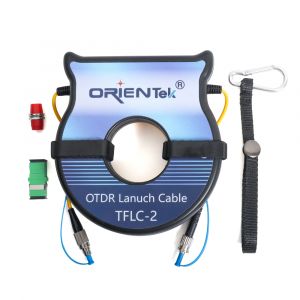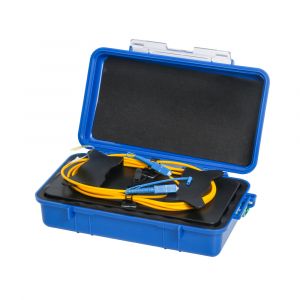What is Optical Fibre? More details please add official account: whatsapp/ skype +8613625297051
Optical fibers are network cables that facilitate data transmission with the use of light pulses that travel along the fibers. These fibers are often made of glass or plastic. Optical fibers use metal wires as they provide prevention from any damage and are not affected by electromagnetic interference.
This technology uses the application of the total internal reflection of light. Based upon the propagation of light, there are majorly two types of optical fibers: Single-Mode Optical Fibers and Multimode Optical Fibers. The former is often used for long-distance signal transmission, whereas the latter is used for short-distance transmission.
Single Mode Fiber Optical Cable VS Multimode Fiber Optical Cable
Both these types of optical fibers have their own attributes and are used as per the specific requirements. But there are distinguishing differences between both types. In the following paragraphs, we will be shedding light on what are the areas that differentiate single-mode and multimode fiber cables.
Difference in Construction
As the name suggests, single-mode optical fiber is built to transmit a single light mode, and multimode fiber is designed to propagate several simultaneous light modes. But the difference between single-mode and multimode fiber does not end there. There is a major difference in their built too. Single Mode Fiber Optical Cable features a 9µm optical core. This eventually helps it with longer transmission distance and higher bandwidth. On the other hand, the optical core in a Multimode Fiber Optical Cable measures at 50µm.

Difference in Bandwidth More details please add official account: whatsapp/ skype +8613625297051
When it comes to bandwidth, both optical fiber types function differently. Single Mode Fiber Optical Cable uses strong and brighter light sources with lower attenuation. At the same time, it can deliver unlimited bandwidth, making it a preferred choice in this high-paced world.
As compared to this, Multimode Fiber Optical Cable can transmit multiple light modes. Also, the attenuation is higher, and the brightness is lower. And this is the reason why the bandwidth is limited in Multimode Fiber optical cables. Higher bandwidth is an obvious choice among users who prefer an uninterrupted experience, so the single-mode optical fiber has the upper hand over Multimode Fiber Optical Cable in this regard.
Difference in Distance

Distance in fiber optical cables means transmission distance, and this is decided by the electronics and their light output capacity. And here also, single-mode optical cables come out as the forerunner. It is capable of both short and long-distance transmission. And at the same time, the transmission is not affected by signal bandwidth or resolution quality. The majority of these can relay up to 10kms over a single-mode fiber cable.
On the contrary, the maximum range of a multimode fiber cable hovers between 300m – 550m. This shorter distance is due to the cable grading that is associated with Multimode Fiber optical cables.
Difference in Cost
Now comes one of the most important deciding factors in any buying/ leasing decision – the price. In a cost-sensitive economy, it is always beneficial for companies to go for the option with better results with the best pricing option. So far, single-mode fiber optical cables have a clear advantage over their multimode counterparts. Also, thanks to stronger light sources and more intricate optical processors, the pricing is expected to be higher. But to assume that they are more expensive than the multimode fiber optical cables will be misleading. Due to the efficiency in manufacturing, single-mode fiber cables are lower priced than multimode cables. Going by numbers, they offer 30% savings over multimode fiber on average.

Difference in Application
The fundamental differences between Single Mode Fiber Optical Cable and Multimode Fiber Optical Cable lead to the difference in their application. The single-mode optical cables are capable of transmitting a single light mode and feature a 9µm optical core. This enables single-mode cables to sustain long-distance transmission. At the same time, this long transmission range does not affect the bandwidth. So, if the requirement is for long-distance transmission, single-mode fiber optic cables are more applicable than multimode cables. On the other hand, due to multiple light paths, the multimode fiber cables are used in projects that require high bandwidth over a short distance range.
Single-mode and Multimode Fiber Cable Types
Both single-mode and multimode fiber cables come in different types based on wavelength, maximum attenuation, minimum overfilled modal bandwidth length, and minimum effective modal bandwidth length. Multimode fiber cables are marked with OM, and single-mode fiber cables are marked by OS. The table below shows the various types of Single-mode and Multimode Fiber Cables with their specifications:

The choice is based on your need
The differences between single-mode and multimode fiber cables are going to play a role in picking up one option for any business project. To sum up, it is advisable that, along with the pros and cons of both types, a project should analyze its needs and opt for the right option.
FAQs
Q: How far can single-mode fiber go?
A: Due to its built, single-mode fiber can go as far as 10kms or more without hurting the signal. This quality makes it ideal for any long-distance transmission.
Q: Can single-mode work with multimode fiber?
A: From a technical point of view, yes. Single-mode fiber can be used in tandem with multimode. But due to the difference in their properties, it is certain that the connection will be very short, unpredictable in nature, and very unreliable.
Q: How do I know if SFP is multimode?
A: There are technical differences between both single-mode and multimode SFP, but to identify them on the first look, one should know about the color-coding of the Bale clasp. The multimode SFP features the Bale clasp in black.
Q: Can single-mode fiber run 10G?
A: Yes, it can. In fact, both single-mode and multimode fiber cables are capable of handling 10G. All one needs to take into consideration is the desired distance to be covered. For long-distance usage, single-mode optical cables are the ideal choice, whereas, for short-range, one can go for multimode optical fiber cables.
Q: How to tell single mode from multimode fiber?
A: Optical fiber cables can be identified by the color-coding of the Bale clasp. The various types of single-mode fiber cables can be seen in the following colors – gray, violet, blue, green, yellow, orange, red, and brown. On the other hand, multimode optical fiber cables have the Bale Clasp in black color.
Q: How to identify the single-mode and multimode fiber patch cord?
A: Apart from the Bale Clasp color coding, single-mode and multimode fiber cables can also be identified by the color of the patch cord. In single-mode optical fiber cable, the patch cord is in yellow color; and in multimode fiber cable, the patch cord comes in orange color.
Q: Can multimode fiber be used for single-mode?
A: Technically, it should not be done as it will lead to massive optical loss. The opposite can be done but replacing single-mode fiber cables with multimode fiber cables is not advisable.
Q: Can you use single-mode fiber with multimode SFP?
A: Single-mode and multimode fiber cables are very different in terms of size, signal transmission, bandwidth, and light source. So, it is not a good idea to use a single-mode fiber cable with a multimode SFP.
More details please add official account: whatsapp/ skype +8613625297051






